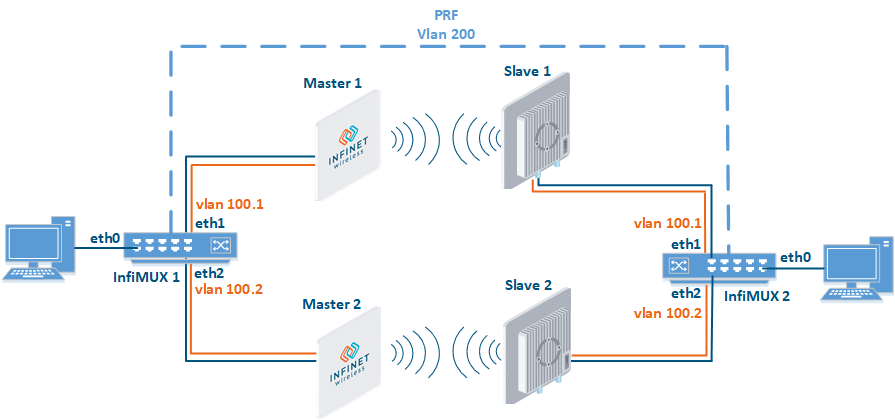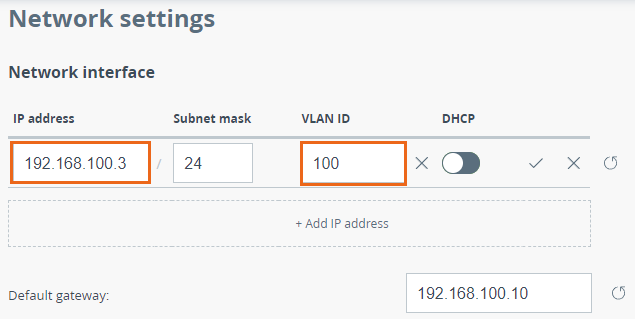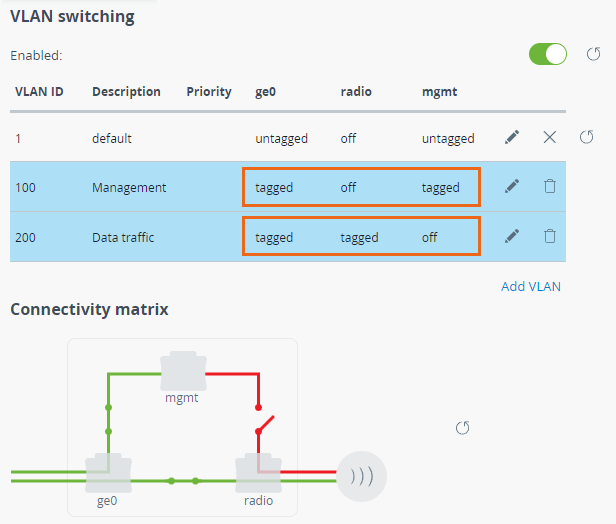Successfully pass the free certification exam at IW Academy and become an Infinet Certified Engineer.
Description
In order to double the throughput of the Quanta 5, Quanta 6 or Quanta 70 based systems, the aggregation technology can be used based on the standard protocols of third-party equipment or InfiMUX switches.
The simplest scheme will be the organization of two links established at the 2 level of OSI via two Quanta 5, Quanta 6 or Quanta 70 devices. LACP protocol excludes loops and allows to double the throughput in compare to the perfomance of the single link.
In this case, the link aggregation is configured on the switches using the LACP protocol. These can be both InfiMUX switches or third-party equipment. Traffic will be balanced between the two links, increasing their total throughput.
Additionally in case one of the links is breaking up, traffic will be completely transferred to the second link.
NOTE
The device management and monitoring are not possible in the described configuration. In order to retain the ability to manage devices, use the configuration method described in the "Management in LAG" section.
Unfortunately, in this case, the use of one frequency for two pairs of devices is not desirable.
Configuration Example
CAUTION
Configurations from the scenarios below are examples that demonstrate the potential capabilities of the Infinet Wireless devices. The configurations may vary depending on the model and firmware version. We do not recommend copying this solutions to the hardware without checking.
Step 1: Configure Master 1 and Slave 1 devices as the first radio link using the following parameters:
- Downlink center frequency: 5055 MHz;
- Uplink center frequency: 5055 MHz (Master only);
- Channel width: 40 MHz;
- Frame length: 5ms;
- Access key: 9876.
Step 2: Configure Master 2 and Slave 2 as the second radio link using the following parameters:
- Downlink center frequency: 5155 MHz;
- Uplink center frequency: 5155 MHz (Master only);
- Channel width: 40 MHz;
- Frame length: 5ms;
- Access key: 6789.
Step 3a: Configure LACP on the InfiMUX switches.
InfiMUX 1 / InfiMUX 2lag 0 port eth1 eth2 ifc lag0 up switch group 1 add eth0 lag0 switch group 1 start
- Step 3b: Configure LACP on the third-party equipment (not included in the example).
Management in LAG
NOTE
This scheme can be implemented only when using InfiMUX switches, the configuration can not be applied for third-party switches.
- VLAN 100 is allocated for device management.
- VLAN 200 is allocated for the traffic transmission. All data traffic will be encapsulated in PRF (including VLAN 100) and forwarded unchanged in VLAN 200 from InfiMUX 1 to InfiMUX 2. VLAN 200 is used only on the network part between InfiMUX 1 and InfiMUX 2, its use in the rest of the network is not prohibited.
- To prevent a loop VLAN 100 transmission over the radio must be disabled.
InfiMUX configuration
Step 1: To transmit VLAN 100, create the vlan100.1 interface over the eth1 physical interface (toward the device of the first radio link), the vlan100.2 interface over the eth2 physical interface (toward the device of the second radio link).
ifc eth1 info "Link 1" ifc eth2 info "Link 2" ifc vlan100.1 up ifc vlan100.1 vlan 100 parent eth1 ifc vlan100.2 up ifc vlan100.2 vlan 100 parent eth2
Step 2: To transmit VLAN 200, create the vlan200.1 interface over the eth1 physical interface, the vlan200.2 interface over the eth2 physical interface.
ifc vlan200.1 up ifc vlan200.1 vlan 200 parent eth1 ifc vlan200.2 up ifc vlan200.2 vlan 200 parent eth2
Step 3: Join the vlan200.1 and vlan200.2 interfaces using the LACP protocol.
ifc lag0 up lag 0 mode fast balance-pp port vlan200.1 vlan200.2
Step 4: Create the PRF interface over the lag0 parent interface.
ifc prf0 up prf 0 parent lag0 mint prf0 -name "MUX-1" mint prf0 -type master mint prf0 -mode fixed mint prf0 start
Step 5: Create a switch group 100, add the eth0 interface, the prf interface to transfer data traffic, and the vlan100.1 and vlan100.2 interfaces to manage radio devices. Create an svi100 interface to manage the InfiMUX switch, assign it an IP-address allocated for management.
switch group 100 add 1 eth0 prf0 vlan100.1 vlan100.2 switch group 100 start ifc svi100 up ifc svi100 192.168.100.1/24 svi 100 group 100
- Step 6: Configure the second InfiMUX switch in the same way.
Wireless devices configuration
- Step 1: Set wireless links between Master 1 - Slave 1 and Master 2 - Slave 2 devices.
Step 2: At the "Network" set the IP address allocated for the device, associate VLAN 100 with it.
Step 3: In the "Switch" section, allow VLAN 200 transmission between the ge0 and radio interfaces. Allow management in VLAN 100 for interface ge0. Note that transmissionover the radion of VLAN 100 and the default VLAN used for local configuration must be disabled. Management in VLAN 200 must be disabled also.
- Step 4: Configure all radio devices in the same way.



